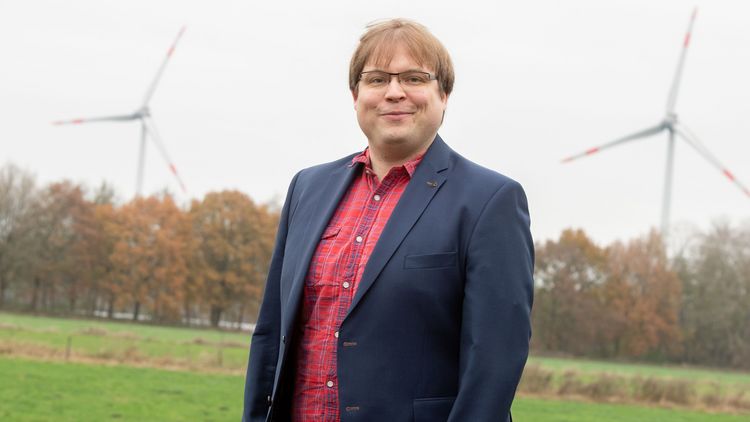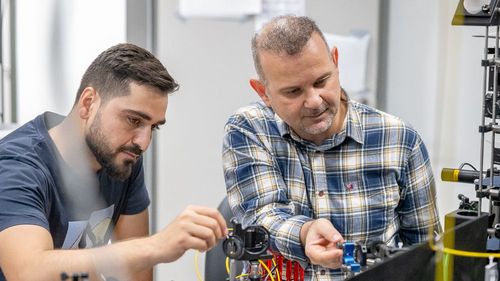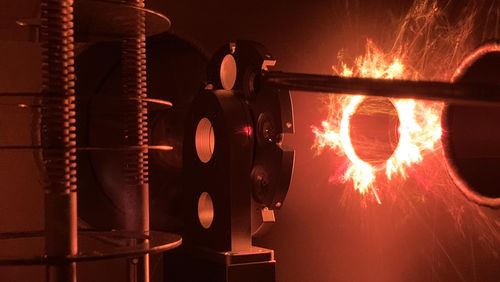Can wind farms be treated as collective systems similar to insect swarms? Physicist and Ossietzky Fellow Michael Sinhuber is combining swarm and turbulence research with the goal of optimising wind farm control.
If there's one thing Dr Michael Sinhuber won't miss about his time at Stanford University, it's the smell. Not that he didn't enjoy his scientific work at the elite US university, or that he didn't make progress there. But only the most dedicated could put up with the smell of his workplace there, because one of his tasks as a postdoc studying the behaviour of flies in a swarm and their reactions to turbulence was to provide the larvae with a steady supply of a gruel consisting of overcooked cellulose and rabbit food. "The acrylic containers stank to high heaven," the physicist recalls, "but as collective systems the swarms provided us with many exciting and also surprising insights." Sinhuber now plans to build on these insights with experiments to be carried out in the wind tunnel at the University of Oldenburg – this time, however, without the participation of insects. With a three-year "Carl von Ossietzky Young Researchers' Fellowship" awarded by the University, he aims to analyse how a model wind farm behaves as a collective system.
The 35-year-old scientist has always been interested in understanding "the big picture" and this led him to study physics in Münster. A native of Oldenburg, Sinhuber initially focused on the numerical simulation of structure-forming systems: "I used the computer to simulate what happens when you heat a container full of water from below and cool it from above at the same time – a process known as Rayleigh-Bénard convection which occurs for example in a saucepan during cooking, but also in the Earth's mantle," Sinhuber explains. This in turn prompted his first forays into the area of turbulence research: "If you create a large enough gap between the temperatures, the system becomes turbulent," he adds. When the opportunity arose to do his doctorate on turbulent flows in the Earth's atmosphere, he jumped at the chance and moved to the Max Planck Institute for Dynamics and Self-Organization in Göttingen. "That's how I transitioned from theory to experiment."
Five years later Sinhuber had his doctorate in his pocket and the next big opportunity came along: a research position at the Civil and Environmental Engineering Department at Stanford University in California, USA. He leapt at the chance, and instead of studying air currents in a wind tunnel in Göttingen he was investigating turbulent flows in polymer solutions, i.e. in liquids in which certain chemical substances consisting of large molecules have been dissolved – an area which has a number of practical applications, as Sinhuber explains, using the example of water in a fire extinguisher: "If you add very small doses of a polymer solution to the water, the jet of water from the fire hose travels much further than pure water. Although the material properties of the water remain almost unchanged, the flow and its turbulence change quite drastically."
Initially, the collective behaviour of insect swarms – particularly in the face of external perturbations such as unexpected optical stimuli or wind – was a secondary area of research for Sinhuber, but gradually became his main focus at Stanford. The leader of his research group had previously conducted research on insect swarms at Yale University, and had brought the equipment for this type of research along with him to Stanford. "We rebuilt it in the lab simply because we had enough space," Sinhuber recalls. He helped put together the aforementioned acrylic boxes in which the fly swarms were to live and which he later had to clean several times a week. "I found it surprising to see that living beings in a collective follow strict physical rules," he says. "We combined methods and concepts from swarm and turbulence research and observed among other things that the more the swarm is disturbed as a collective system, the stronger the correlation between the trajectories and speeds of the individual flies."
During the experiments Sinhuber and a fellow postdoctoral researcher were able to take advantage of the fact that the fly species they were using spends most of its life in the larval stage, and during its two-day lifespan as an adult fly concentrates its efforts on reproduction. Twice a day – at dawn and dusk – the flies consistently formed mating swarms. And when exposed to disturbances, the responses of the swarm as a collective varied considerably depending on the nature of the disturbance factor. Sinhuber found that when an object was moved back and forth in front of the Plexiglass container the swarm's behaviour resembled a viscous swirling gel. "The swarm didn't move back and forth as a block with the optical signal; instead a wave of information passed through it," Sinhuber explains. "The flies don't react as independent individuals to the disturbance factor – there is a certain flow of information through the swarm as a whole." Using mathematical methods, he also discovered parallels between the behaviour of a swarm of flies and thermodynamic systems such as gases. "When you go that deep, you can really identify collective behaviour."
Sinhuber's fascination with these effects led him to ask, "Could this also be applied to man-made systems?" Wind farms seemed to him to be an obvious option for studying this question. Wind turbines can be controlled individually, he explains, but each turbine also influences the flow conditions for all the other turbines – so could they be interpreted as a collective system, like a swarm of insects? "That was the starting point for my decision to return to Germany and more specifically to Oldenburg." Sinhuber had already had previous contact with Prof. Dr Joachim Peinke's research group "Turbulence, Wind Energy and Stochastics". This made his move to the University of Oldenburg in March easier when – due to the coronavirus pandemic – he was unexpectedly confined to working from home, where theoretical work, research proposals and overseeing the bachelor project of his first student assistant have kept him busy ever since.
But as soon as the infection situation allows it, he will begin his experiments in the ForWind wind tunnel. Using wind turbine models, he hopes to gain a better understanding of how wind farms behave during turbulence. "Ultimately, this could contribute to further improving wind farm management – and could also be applied to other collective systems such as drone swarms for sea rescue or terrain reconnaissance operations," Sinhuber hopes.






